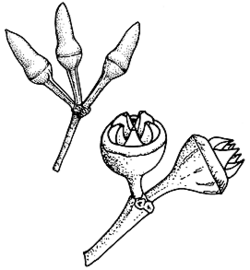Common name: Forest Red Gum, Buringoa (D'harawal)
Eucalyptus tereticornis Sm. APNI* 
Description: Tree to 50 m high; bark smooth, white or grey, shedding in large plates or flakes.
Juvenile leaves disjunct, broad-lanceolate to ovate, dull blue-green or green.
Adult leaves disjunct, narrow-lanceolate or lanceolate, 10–20 cm long, 1–3 cm wide, green, dull, concolorous. Umbellasters 7- to rarely 11-flowered; peduncle narrowly flattened or angular, 7–25 mm long; pedicels terete, 3–10 mm long. Buds cylindrical or fusiform, 10–20 mm long, 4–8 mm diam., scar present; calyptra conical or elongate acute, longer than and as wide as hypanthium.
Fruit globose or ovoid, 4- or 5-locular, 4–6 mm long, 4–8 mm diam.; disc raised; valves exserted.
Flowering: Has been recorded in flower over most of the year.
Distribution and occurrence: Widespread in eastern Australia. North from Bega. Community dominant, widespread in grassy, wet or dry forest or woodland on soils of medium to high fertility.
NSW subdivisions: NC, CC, SC, NT, CT, ST, NWS, CWS
Other Australian states: Qld Vic.
A complex and variable species, occurring in a range of habitats and intergrading with E. blakelyi in several areas such as the upper Hunter, Goulburn, Cox and Kowmung R. valleys. Hybrids with E. robusta are not uncommon where they occur in close proximity. They have been known as E. patentinervis R. T. Baker and have been recorded as a koala food tree (e.g. near Port Macquarie).
Text by K. Hill; updated by Peter G.Wilson, April 2020.
Taxon concept: Flora of NSW 2 (1991); EucLID ed. 4 (2020)
APNI* Provides a link to the Australian Plant Name Index (hosted by the Australian National Botanic Gardens) for comprehensive bibliographic data
***The AVH map option provides a detailed interactive Australia wide distribution map drawn from collections held by all major Australian herbaria participating in the Australian Virtual Herbarium project.
|


